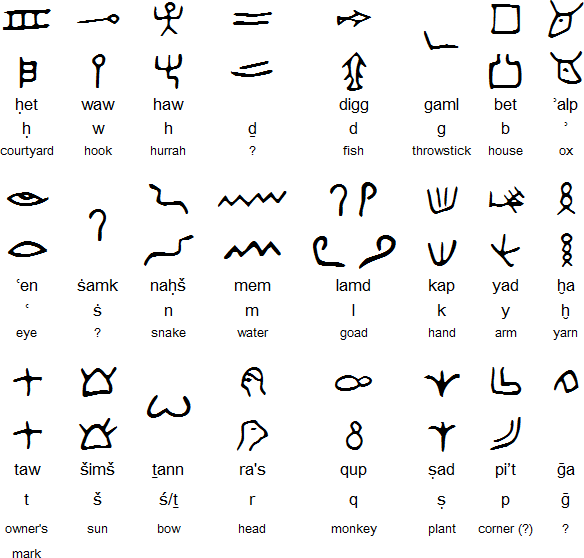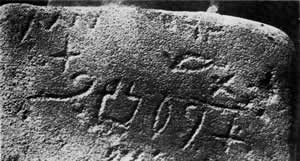The Proto-Sinaitic script was the first alphabetic writing system and developed sometime between about 1900 and 1700 BC. People speaking a Semitic language and living in Egypt and Sinai adapted the Egyptian hieroglyphic or hieratic scripts to write their language using the acrophonic principle. This invovled choosing about 30 glyphs, translating their Egyptian names into the Semitic language, and using the initial sounds of those names to represent the sounds of their language.
For example, the Egyptian nt (water) became mem in Semitic and represents the sound /m/, and eventually developed into the Latin letter M.
Inscriptions in Proto-Sinaitic have been found at Serabit el-Khadim (سرابيت الخادم) a mountain in Sinai and at a temple for the Egyptian goddess Hathor (ḥwt-ḥr) that is located there. The script was partially deciphered by Alan Gardiner in 1916. Inscriptions very similar to those found at Serabit el-Khadim have been found at Wadi el-Hol (وادي الهول).
Proto-Canaanite is a name used for a version of the Proto-Sinaitic script as used in Canaan, an area encompassing modern Lebannon, Israel, Palestine and western parts of Syria. It is also used to refer to an early version of the Phoenican script as used before 1050 BC, or an ancestor of the Phoenician script.
A small number of Proto-Canaanite inscriptions dated to the 17th century BC have been found in Canaan. Most are short and were probably written by Semitic-speaking travellers or soldiers from Egypt.
This is one version of the Proto-Canaanite script using Phoenician/Hebrew alphabetical order. The actual arrangement of letters used is uncertain. Most letters have more than one shape.


From Serabit el-Khadim, Sinai Pennisula and dated to c. 1500 BC.
Information about the Proto-Sinaitic / Proto-Canaanite scripts
http://en.wikipedia.org/wiki/Proto-Sinaitic_script
http://www.apocalypse2008-2015.com/Proto-Sinaitic_Hebrew.html
http://en.wikipedia.org/wiki/Proto-Canaanite_alphabet
Free Proto-Canaanite font
http://www.bibleplaces.com/paleo_hebrew_fonts.htm
http://ancientroadpublications.com/Fonts.html
Akkadian, Amharic, Arabic (Algerian), Arabic (Bedawi), Arabic (Chadian), Arabic (Egyptian), Arabic (Gulf), Arabic (Hassaniya), Arabic (Hejazi), Arabic (Lebanese), Arabic (Modern Standard), Arabic (Moroccan), Arabic (Najdi), Arabic (Sudanese), Arabic (Syrian), Aramaic, Argobba, Assyrian / Neo-Assyrian, Canaanite, Chaha, Chaldean Neo-Aramaic, Ge'ez, Hadhramautic, Harari, Hebrew, Himyaritic, Jewish Neo-Aramaic, Maltese, Mandaic, Nabataean, Neo-Mandaic, Phoenician, Punic, Qatabanic, Sabaean, Sabaic, Silt'e, Syriac, Tigre, Tigrinya, Turoyo, Ugaritic, Western Neo-Aramaic
Ancient Berber, Arabic, Aramaic, Chorasmian, Elymaic, Hatran, Hebrew, Manichaean, Nabataean, North Arabian, Pahlavi, Palmyrene, Parthian, Phoenician, Paleo-Hebrew, Proto-Sinaitic / Proto-Canaanite, Psalter, Punic, Sabaean, Samaritan, Sogdian, South Arabian, Syriac, Tifinagh, Ugaritic
Page last modified: 28.09.23
[top]
You can support this site by Buying Me A Coffee, and if you like what you see on this page, you can use the buttons below to share it with people you know.

If you like this site and find it useful, you can support it by making a donation via PayPal or Patreon, or by contributing in other ways. Omniglot is how I make my living.
Note: all links on this site to Amazon.com, Amazon.co.uk
and Amazon.fr
are affiliate links. This means I earn a commission if you click on any of them and buy something. So by clicking on these links you can help to support this site.
[top]